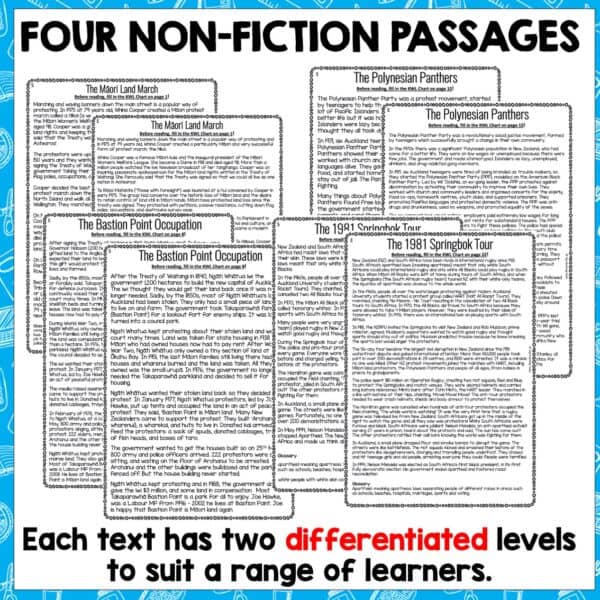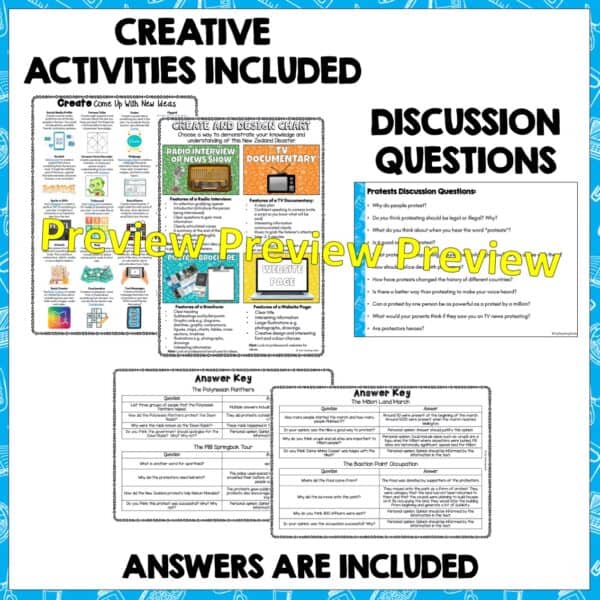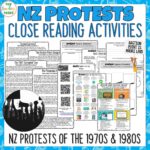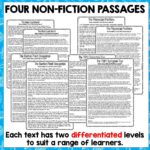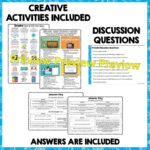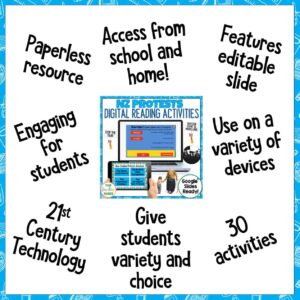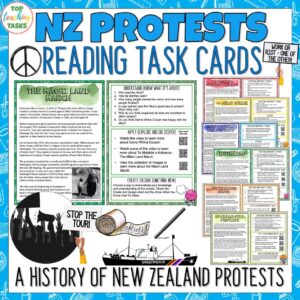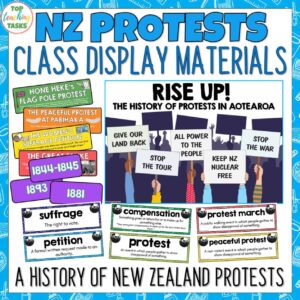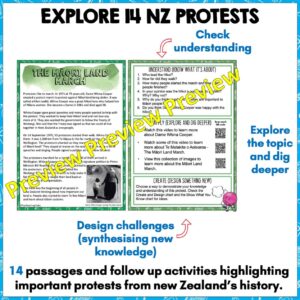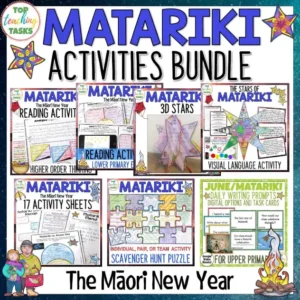New Zealand Protests Reading and History Passages and Questions
NZ$8.25
Description
Explore four of the significant protest movements from the 1970s and 1980s that created change for Aotearoa New Zealand and its people, and shone a light on important causes, both locally and internationally. This New Zealand Protests Reading and History activity pack includes four non-fiction passages with a variety of unique and engaging text-dependent questions and higher-order thinking tasks.
These activities are great for your guided reading program, or as homework tasks. Integrate these activities into your history and/or social studies projects! These link closely to New Zealand’s Literacy Progressions and National Curriculum for Reading and Social Studies.
In this New Zealand Protests Reading and History pack you will receive:
1. Four texts – all with an extended and scaffold version:
- The Māori Land March
- The Bastion Point Occupation
- The Polynesian Panthers
- The 1981 Springbok Tour Protests
2. SIX corresponding NO PREP Higher Order Thinking Activities – that’s 24 activities in total.
Each passage features different activities!
- Remember
- Understand
- Apply
- Analyze/Analyse
- Evaluate
- Create
Reading Comprehension Strategies included:
- Find Facts and Details
- Make Inferences
- Identify the Main Idea
- Ask and Answer Questions
- Use Vocabulary
- Summarise
- Synthesise
- Compare and Contrast
- Make Predictions
- Make Connections
3. A set of broad discussion questions to encourage oral discussions and the sharing of opinions (evaluating – Higher Order Thinking).
4. A set of perspective cards to encourage students to consider a range of perspectives in each protest.
5. Three Graphic Organiser Examples
- Information Web
- Main Idea
- Venn Diagram
6. Teacher Answer Key for applicable questions.
7. Two ‘Tips For Use’ pages with ways to use this resource in your classroom.
What this resource is all about:
The purpose of this resource is to provide ready-to-go non-fiction passages and engaging higher-order thinking questions.
This resource is full of exciting, thought-provoking activities to grab your students’ attention AND hold it. The activities begin at the lower levels of Blooms Taxonomy (Remember, Understand, Apply) and move through to the higher levels (Analyze, Evaluate, Create).
Aotearoa New Zealand Histories Curriculum Links:
Tino rangatiratanga me te kāwanatanga | Government and organisation
- Year 5-6: Governments have selectively supported or excluded people through processes associated with voting rights, access to education, health, and welfare provision, reflecting prevailing public attitudes of the time. Often equitable treatment has been sought by people, including Māori, Chinese, women, children, and disabled people.
- How, over time, have various New Zealand governments restricted voting rights? How have people advocated for their rights? How did the Government respond to the hardships of the Great Depression?
Whakapapa me te whanaungatanga | Culture and identity
- Year 7-8: Mid-twentieth-century Māori migration to New Zealand cities occurred at an unprecedented pace and scale, disrupting the whakapapa of te reo and tikanga and depopulating papa kāinga. New approaches to being Māori and retaining iwi values and practices were created and debated. Movements to reassert Māori language, culture, and identity arose throughout the country.
- What were the challenges Māori faced after the Second World War? What do hapū and iwi say about their relocation to the cities and the reasons for it? What has this meant for their identity as Māori?
Tino rangatiratanga me te kāwanatanga | Government and organisation
- Year 7-8: Mana was central to all political and economic relationships in traditional Māori society and has continued to shape internal and external interactions.
- How was mana expressed in relationships between iwi and between iwi and Pākehā?
- How did iwi co-opt new ideas and technologies in the pursuit of mana, and what were some of the impacts of that?
- How did diseases brought by Europeans impact mana?
- How is mana evident in Māori protest actions?




